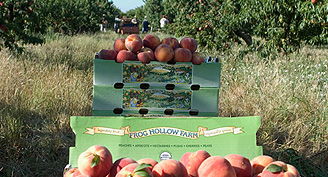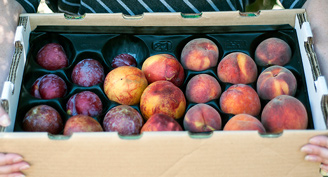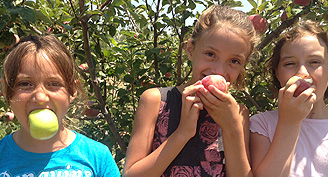This Week's Fruit
Hass Avocados Las Palmalitas, Carpinteria, CA Creamy in texture, nutty in flavor, with a small to medium seed. The Hass skin is easy to peel and darkens from green to purplish-black as it ripens. You can tell it is ripe by the color of the skin (dark) and if it yields to pressure. Pink Lady Apples Cayuma Orchards, New Cayuma, CA A cross between the Golden Delicious and Lady Williams, the Pink Lady is a crisp and juicy apple with a tart finish. A creamy white colored flesh that resists browning makes this an excellent apple for salads and slicing. Also a modern day favorite for eating out of hand. A cross between the Golden Delicious and Lady Williams, the Pink Lady is a crisp and juicy apple with a tart finish. A creamy white colored flesh that resists browning makes this an excellent apple for salads and slicing. Also a modern day favorite for eating out of hand. Hayward Kiwi Chiechi Farms, Live Oak, CA Originally known as the Chinese gooseberry due to its Chinese orgins. Hawyward Wright, a New Zealand nurseryman propagated his plants by grafting and they eventually became the preferred cultivar of growers due to their sweet flavor and thin skin. Navel Oranges Etheridge Farm, Dinuba, CA California Navel Oranges are considered to be the best Navels for eating out of hand. They have a thick skin that is easy to peel, are seedless, and have a meaty and sweet flesh that makes them a perfect snack. Navels are also great for juicing and cooking. Murcott Tangerines Etheridge Farm, Dinuba, CA Murcott Tangerines are late season tangerine known for their rich flavor and deeply hued flesh and juice. Their small size and sweet juice makes them a favorite with little ones. Sanguinelli Blood Oranges Frog Hollow Farm, Brentwood, CA Sanguinelli is the latest variety of our blood oranges. The flesh is sweet and ranges in color from orange with dark red streaking to a dark red maroon. Sanguinellis are usually seedless.A Note from Farmer Al
Dear CSA Members, Our long, lucky period of no rain in any blossoms ended over the weekend with several torrential downpours. Our peaches, nectarines, plums and apricots are fine…they have long since passed their vulnerable period of full bloom and are now showing lots of fruit. It’s the growth stage known as fruit set. And they all have nice crops. It’s the late blooming fruits we’re worried about…pears, apple and cherries. I walked through the muddy ground today to inspect the cherries and was relieved and delighted to see a nice fruit set on our earliest variety, the Brooks. But, it’s still a bit early to tell on the Bings and Rainiers. The pears and apples are the most at risk crops for a rain event like we just had. They are susceptible to the dreaded disease known as fire blight. Fire blight is caused by a bacteria erwinia amylovora, which begins in the soft tissue parts of the blossom during warm wet, weather. It will quickly spread into the shoot that the flower clusters are growing on, and then race down through the cambium layer of the shoot to the main branch or trunk of the tree. If this infected wood is not identified and removed by pruning, it will kill the whole tree, often in a matter of weeks or months. The very best way to avoid this killer disease is to plant varieties which are immune or resistant to it. Our Warren pear is one such variety. It will not get sick, which is wonderful and amazing. However, the Golden Russet Bosc and the Taylors Gold varieties are extremely susceptible and over the last several years (since that miserable warm wet spring of 2011) we have lost over 300 trees, about 25% of the total trees of those varieties. The Pink Lady, our very best apple variety is the most susceptible of all! So, this is the dark shadow that will haunt us for the next few weeks, and we’ll have to be hyper-vigilant in walking through these orchards and identifying any out breaks at the earliest possible moment.







